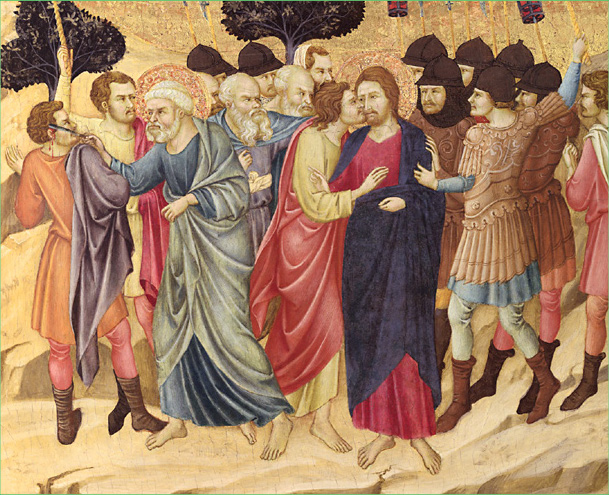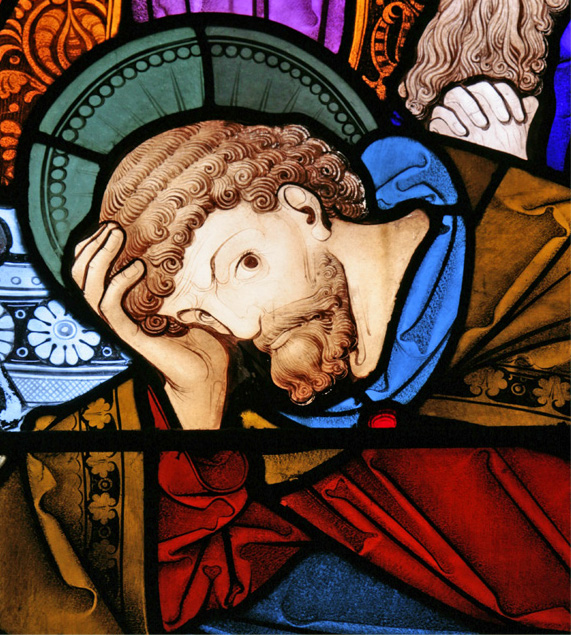
IN BRIEF
Matthew 26:46-56; Mark 14:42-52; Luke 22:47-53; and John 18:1-11
Betrayal of Jesus
c.29 CE The Garden of Gethsemane, Jerusalem, in the last week of the life of Jesus.
Jesus The Messiah and Son of God at the end of His time on earth, as He prepares to be crucified in Jerusalem.
Judas Iscariot One of Jesus’s 12 disciples, who betrays Him by leading the authorities to the Garden of Gethsemane.
After the Last Supper, Jesus retires to the Garden of Gethsemane to pray, in an event which is often called the “Agony of Jesus.” There He is “deeply distressed and troubled,” and tells His disciples: “My soul is overwhelmed with sorrow to the point of death” (Mark 14:34). Jesus knows that the end is near, and indeed, the Garden of Gethsemane is the place where Jesus is betrayed by one of His own followers.
This story is within the Gospel narratives called the Passion: the cycle of Jesus’s arrest, crucifixion, and resurrection. For the most part, all four Gospels agree in their depiction of the betrayal, albeit with different emphases. Judas, one of the 12 disciples, leads the Temple guards to Jesus in the garden. The three Synoptic Gospels (Matthew, Mark, and Luke) write that Judas betrays Jesus with a kiss, which identifies Him to the guards. A kiss was a significant gesture at the time, often given by a student to a teacher as a sign of honor and respect. It is notable that Judas calls Jesus “rabbi” and performs this gesture of respect in the very moment he hands Him to those who would kill Him.

Necessary betrayal
John is the only Gospel not to mention the kiss. Instead, he focuses on a fight that breaks out between the disciples and the guards, and one of the 12 (John says it is Peter) cuts the ear off a soldier. Jesus stops the violence and goes willingly—according to Luke, He even heals the soldier’s ear. He tells Peter “Put your sword away! Shall I not drink the cup the Father has given me?” (John 18:11). His “cup” here is a metaphor for His destiny. According to John 13, Jesus already knew that He would be betrayed, and He knew that He was going to die. In fact, Jesus’s death and resurrection is a fundamental pillar of Christian theology, which makes Judas’s betrayal a crucial act: Matthew 26:56 states that the betrayal is necessary so that the writings of the prophets are fulfilled.
Judas, however, had his own motives. Despite numerous theories, no one knows why he decided to betray Jesus. According to Matthew 26:14–16, Judas betrays Jesus for money and he receives 30 pieces of silver for leading the guards to the garden. Luke agrees that Judas received money, but declines to inform the reader of the amount; according to Luke, Judas only goes to the chief priests in the first place because he is possessed by Satan (Luke 22:3).

Garden motif
Whether it is the Hanging Gardens of Babylon or the Garden of Eden, the garden is seen as a special place in the ancient Near East. Gardens—especially those in the desert—were understood as places where the divine can interact with the earthly. While the Garden of Gethsemane is not the Garden of Eden, the story of Jesus’s betrayal is related to that in Genesis. Adam and Eve’s betrayal of God leads to death entering the world, while Judas’s betrayal of Jesus leads to Him conquering death.
Judas Iscariot

The Greek version of the Hebrew name Hudahudas, Judas means “the one who praises.” No one knows what “Iscariot” truly means: some believe that it is the nowunknown place Judas came from, while others have suggested that the name might relate to a group of Zealots called the Sicarii.
Scholars have long debated Judas’s motives in betraying Jesus. A popular theory was that Judas wanted to bring about a war between Romans and Jews, and when Jesus did not make this happen, Judas turned Him in to the officials. In the so-called “Gospel of Judas”—a 2nd-century CE text composed by a Gnostic writer, comprised of conversations between Judas and Jesus—Jesus Himself tells Judas to betray Him.
The betrayal ends with not one death, but two. Matthew 27 states that after Jesus is condemned, Judas returns the money and hangs himself in remorse. Acts 1:18 has a gory alternative: Judas buys a field with his blood money and, falling down in it, dies, his body bursting open and his intestines spilling out.
See also: The Last Supper • Peter’s Denial • The Crucifixion • The Empty Tomb
